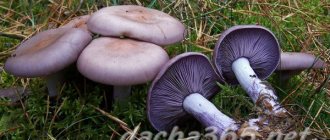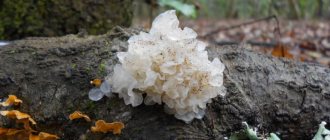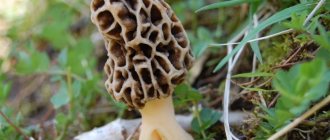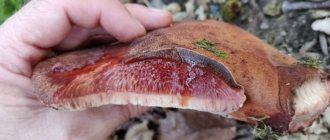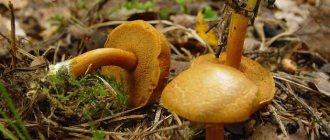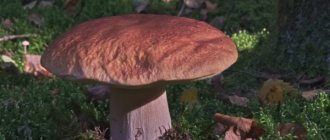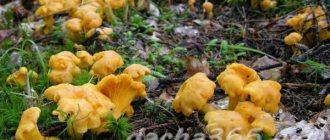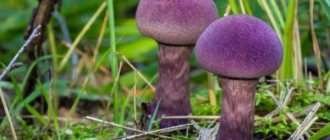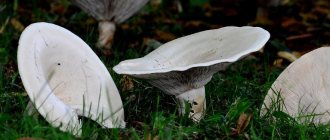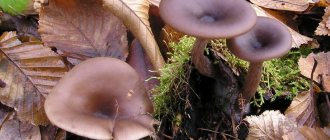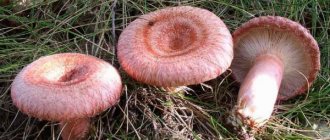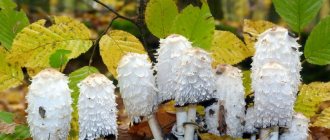Steppe morel is an edible mushroom belonging to the third food category.
This mushroom is the real king of spring mushrooms. And he bears this title for a reason. Firstly, it is the largest representative of early spring mushrooms. Secondly, it is perhaps the only one of the “mushroom snowdrops” that refers to edible, and not conditionally edible, mushrooms, which eliminates the need for lengthy boiling and other pre-processing methods. And finally, it is one of the most delicious early mushrooms.
Types of morel mushrooms
The Morel genus has not yet been well studied. There are more than 80 species in this group. This is a complex classification that is constantly changing and does not have clear criteria. All varieties have a similar structure and are considered conditionally edible.
Tall morel
The variety is distinguished by its large size: it reaches 5 - 15 cm in width, 30 cm in height. The fruiting body is dark in color, covered with triangular-shaped cells and narrow vertical folds. Specimens are collected in May, less often in June. The tall species is found on the edges of forests and mountainous areas.
In young specimens, the cells are brown with an olive tint, in mature specimens they are brown, almost black, and the partitions are ocher. The mushroom stem is cylindrical and has a granular texture. Its height reaches 15 cm, diameter - 3 cm. The leg, initially white, gradually becomes yellowish.
Conical morel
In the conical variety, the cap has an elongated shape, its edges grow tightly to the stem. The height is from 6 to 18 cm. The diameter of the cap is from 2 to 8 cm, the height is up to 9 cm. The color of the conical representative is varied, from yellow to brown. Most often they are brown or grayish in color.
The inside of the cap has an empty cavity. On top there are convex folds of a darker color. Externally, the surface resembles cells stretched from top to bottom.
The leg is cylindrical, up to 5 cm high, 3 cm thick. Its inner part is also hollow. The surface of the leg is velvety, covered with grooves. The flesh of the conical type is cream or white. It is thin, fragile, tender, and dries quickly. There is no taste or smell.
Important! Conical morels are quite rare. The fungus grows slowly, this process takes up to two weeks.
Real morel
Edible morel, or real morel, is the most popular variety. Its fruit body is large, fleshy, the inside is hollow. This mushroom reaches a height of 20 cm, while having a small mass.
Representatives of this species have an egg-shaped cap, often round, sometimes flattened. The edges are in close contact with the leg. The height of the cap is up to 7 cm, its girth reaches 3 - 8 cm. There are specimens with yellow, brown and gray colors. Gradually their color darkens. The cap has an uneven surface; it consists of numerous depressions.
The edible leg is hollow, cylindrical-shaped, with voids inside. It breaks easily and has a whitish color. With age, this specimen acquires a yellow or beige color. Its pulp is light, ocher or cream in color, and is easily crushed. The taste is pleasant, there is practically no smell.
Semi-free morel
The mushroom has a pronounced stem and cap. Its average height is 10 cm. Sometimes representatives of this group grow up to 20 cm. Their internal cavities are not filled with anything. The cream stem breaks easily. Its height is from 5 to 12 cm, its girth reaches 3 cm. Its surface is rough to the touch.
The cap reaches 2 - 4 cm in height. Its upper part fuses with the leg, its edges remain free. There are irregular folds on the surface. There are clear ribs that gradually turn black. The color of the cap is brown, light or dark.
Steppe morel
This large mushroom grows up to 25 cm in height. Its weight reaches 2 kg. Prefers open areas: steppes, meadows, clearings. The steppe variety has a gray-brown spherical cap measuring from 2 to 10 cm, the edges of which grow to a cream-colored stem.
The steppe species is developing rapidly. The fruiting body is formed in 7 days. In spring, the steppe variety often grows in groups. If the winter turns out to be little snow, then the mushrooms do not have enough moisture to develop. The dense white pulp is characterized by the absence of voids. Numerous cells are clearly visible on the cap.
stinky morel
The mushroom is also known as Veselka vulgaris. It reaches a height of 10 - 30 cm. Its fruit body is egg-shaped, with a girth of 6 cm. The shell is leathery, smooth, white or cream-colored. Inside there is gelatinous pulp.
As the vesel grows, a spongy cylindrical leg forms. Then a cap up to 5 cm high is formed. Its surface is cellular, mucous, dark olive in color. There is a disc-shaped hole at the top. Mature specimens have an unpleasant rotting odor.
Veselka vulgaris is not used when it reaches full maturity. Within a few hours, the pulp decomposes. Veselka is harvested in the early stages of growth, when it has the shape of an egg or a traditional mushroom.
Attention! The stinking morel has the highest growth vigor in nature. In a minute its dimensions increase by 5 mm.
Common String Gyromitra esculenta
String OrdinaryGyromitra esculenta
A great friend of especially crazy mushroom pickers. Belongs to a species of marsupial fungi of the genus Strochok, family Discinaceae. Its scientific name is curious, a mixture of Greek and Latin meaning "round edible headband." In English-speaking countries it is called "mushroom brain" - all because of its characteristic shape.
It grows in April and May on sandy soils, places of former forest fires, and deforestation areas. Mostly found under coniferous trees, likes to grow next to poplars.
Appearance
The cap is visually similar to the human brain, up to 10 cm high and up to 15 cm wide. In young specimens it is smooth, but as it ages it becomes wrinkled. The color of the cap is usually brown, but there are mushrooms with purple, red and orange colors.
The leg is from 2 to 3 cm long, and with a diameter from 2 to 6 cm, hollow inside, light in color, sometimes with pinkish notes. It tapers towards the base and is dense to the touch.
The pulp is thin, waxy with a very pleasant, slightly fruity smell and not bad taste.
Is it worth it?
The danger of eating stitches
Among mushroom pickers, there has been a debate since ancient times about whether it is dangerous or not to eat stitches. On the one hand, their very Latin name implies that they are edible. Strings also grow in Europe and North America, and have been eaten there for hundreds of years. However, it has been scientifically proven that these mushrooms contain the carcinogenic toxin gyromitrin, which negatively affects the liver, gastrointestinal tract and autonomic nervous system. Gyromitrin is metabolized in the body with the elimination of the formyl group and aldehyde, forming toxic methylhydrazine.
Cases of string poisoning have been recorded, with symptoms ranging from normal vomiting to falling into a coma.
There are two ways to detoxify stitches:
- Boil for half an hour, drain the broth and rinse the mushrooms with running water - the methylhydrazine will leave with the broth. You can boil it twice in a row.
- Dry for a long time and thoroughly in the open air - the methylhydrazine will evaporate.
But the toxins will completely leave the stitches only if they are dried outside in the sun for at least six months, which is simply unrealistic in Russian natural conditions. These toxins may also not cause a clinical picture of poisoning, but slowly accumulate in the body. There is a theory that the strains of gyromitrin in the composition of the lines may differ, and some of them are not destroyed by digestion.
Experienced mushroom pickers say that it all depends on the degree of poison in each particular mushroom and the individual characteristics of the eater. You can chew a raw line without any consequences, but you can be seriously poisoned by one that has been washed and boiled for many hours. Here everyone decides for himself whether he is ready to risk his health.
In any case, the lines can be eaten only in a well-cooked form.
What do morel mushrooms look like?
Morels are large mushrooms with a fleshy, fragile fruiting body. They usually consist of a stem and a cap. Their surface is wrinkled, reminiscent of a honeycomb, only empty and narrower. The bell-shaped cap has a spore-bearing layer, its surface is spongy or wavy. The edges may adhere to the stem or remain free. The color of the cap is brown.
The height of the mushrooms is 2 to 25 cm. Their legs are white, brown or yellowish, cylindrical in shape. Sometimes there is a thickening near the base. The surface of the leg is smooth or scaly.
The fruiting body has cavities inside and consists of numerous branches. They are separated by partitions; in the center there are pores for the transfer of useful substances. The pulp is white, waxy, thin, and breaks easily.
Stitch Giant Gyromitra gigas
String Giant Gyromitra gigas
In general, String Giant is similar to String Ordinary, but differs in the larger size of the cap, its lighter color, the structure of the spores and the fact that it prefers birch to poplars. It grows from mid-April to early June in deciduous forests, often near fallen birches and old stumps, on the edges of the forest. Loves well-lit and warm places. Sometimes found in large groups.
Appearance
The cap is from 8 to 30 cm in diameter, yellowish in color, firmly attached to the stem.
The leg is hollow, wide, irregular in shape, whitish in color, 2-3 cm long, furrowed and folded. It can be sunk into the soil, often completely covered with a cap.
The pulp is brittle, thin, waxy. It has a good taste and a pleasant mushroom smell, but the Giant String is also classified only as a conditionally edible mushroom.
These two types of stitches have a relative, Autumn Stitch Gyromítra ínfula, which, as the name implies, grows at the end of the year. It is similar in shape to the cap, but it is smoother, unlike the brain, with characteristic horns-blades on it. Contains the same toxins as its counterparts.
Stitch Autumn Gyromítra infula
Where do morels grow?
Often these representatives are found in parks, forest and steppe areas. In addition, they appear in the 3rd – 4th year after fires and fellings.
In what areas do morels grow?
The morel grows in a temperate climate zone. It is collected in Eurasia, North America and Australia. Some species are found in Mexico, India, and Turkey.
Five varieties are well known in Russia. Morel mushrooms live in the Moscow region, Tver, Ulyanovsk, Samara, Rostov regions. They are also found in the Urals, Altai, Siberia, and Primorsky Territory.
In which forests do morels grow?
Morels prefer well-lit areas. They grow in fertile soil saturated with lime. They are more often found alone, rarely forming groups. They are collected in coniferous and mixed forests, parks and apple orchards.
Sometimes representatives of the Morel family appear on sandy soils. In the southern regions they are collected from lawns and garden plots. When searching, it is recommended to check ravines, banks of rivers and streams, fallen trees, but it is easier to conduct a “silent hunt” in clearings, lawns, and next to forest paths overgrown with tall grass.
Mushrooms similar to morels
Morels are similar in appearance to other mushrooms that grow in early spring. They are often confused with strings that contain dangerous poison and are called false morels.
Strog is a spring marsupial mushroom similar to a morel. When eaten, the toxin that the mushroom contains changes the composition of the blood. The lethal dose of such a product is 0.4 - 1 kg. To remove poison from the pulp, you need to cook it for at least 10 minutes. All the poison then goes into the water, which must be drained. Then the mass is washed with clean water.
The stitch and the morel have obvious differences. The first ones have a shapeless cap that resembles the convolutions of the brain. Morels have a cone-shaped, elongated cap. The lines do not push the soil apart, but grow through it, so their stems need to be cleared of soil, small branches and other debris.
To distinguish between these types of mushrooms, you need to cut off their stem. Morels have a hollow interior, not filled with anything. The stitches are distinguished by a uniform, sinuous flesh; In addition, they do not have a pronounced mushroom smell.
Use
The Steppe morel is the only type of early spring mushroom from morels and strings that does not require pre-treatment. To be completely sure, you can boil it for 15 minutes, and then subject it to any cooking methods.
The steppe morel is a delicious mushroom; it makes excellent sauces; when dried, it is an excellent seasoning, although the drying process is somewhat difficult. The main difficulty when drying steppe morels is the need to remove particles of soil and sand from its many folds.
This type of morel is dried either in the sun or in special dryers. The first method is preferable because it allows you to preserve the maximum amount of beneficial properties and flavors of this mushroom.
Why are morels useful?
Since ancient times, representatives of morels have been used to treat eye diseases, improve myopia and age-related farsightedness. The composition contains substances that strengthen the eye muscles and protect the lens from clouding. Based on these fungi, drugs are being developed to combat cataracts.
In folk medicine, the product is used to treat diseases of the stomach and intestines. A tincture of these mushrooms is a good remedy against conjunctivitis. The pulp also contains polysaccharides, which suppress the activity of cancer cells and viruses and stimulate the immune system.
First aid for morel mushroom poisoning
In case of fungal poisoning, the victim is given first aid:
- wash the stomach;
- give activated carbon or other sorbent to drink;
- include drinking large amounts of warm liquids.
It is necessary to quickly remove dangerous toxins from the patient’s body. A doctor is called to treat the poisoning. The specialist will prescribe treatment or decide to transfer the patient to a hospital. The rehabilitation period takes up to several weeks, depending on the age and condition of the victim.
